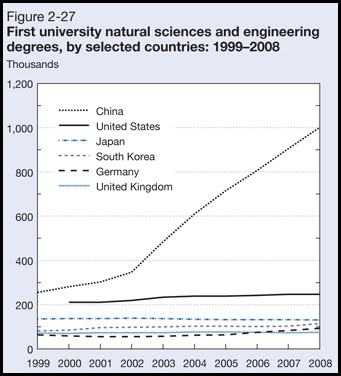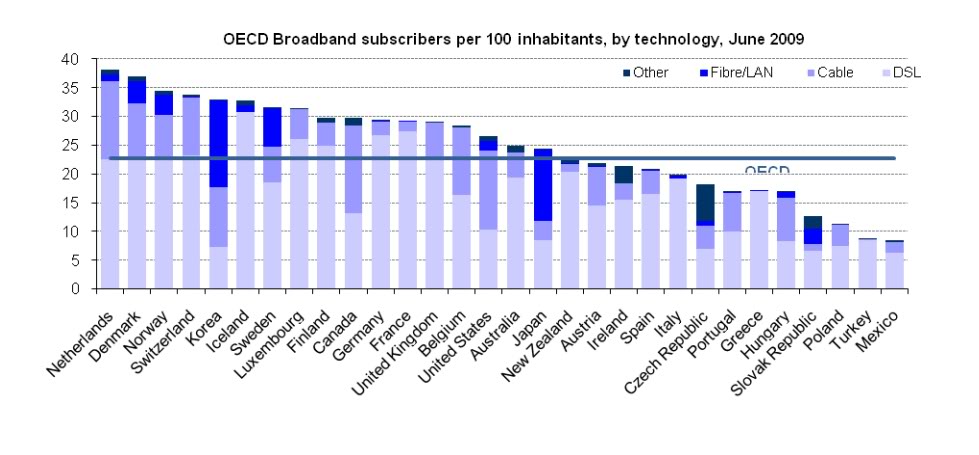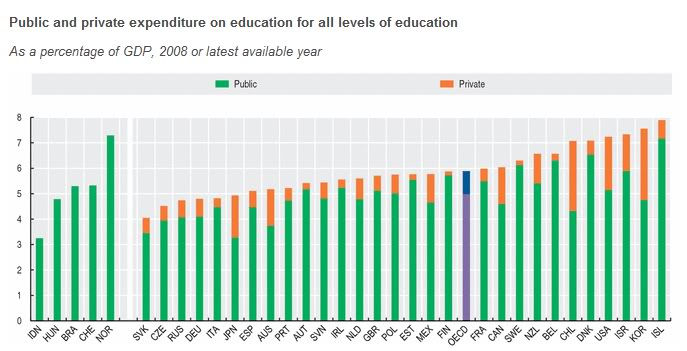EDUCATION SPENDING
AN AREA WHERE AMERICA SPENDS MORE AND GETS LESS
The Myth That We Need More Education Spending
Many people believe that a lack of funding is a problem in the education system. Yet as a percent of GNP, America we already spends more on education than most other modern states. Historically, education spending is at an all-time high. High School graduation rates have barely budged since the 90's. In 1990, the average graduation rate was 73.7 %. By 2005 there was a modest increase to 74.7%, despite enormous increases in spending. Mindlessly throwing money at the problem is not working. We need reforms in resource allocation rather than a spending increase. Specifically, we need reforms that reflect the technological needs of the 21st century job market. Part of this strategy involves implementing a National Broadband Network, as many modern states have already done.
We need an education system oriented to job skills. We also must have universal access to high speed broad band so people can learn outside the confines of America's totally inefficient education system. In particular, we need to end the fairy tale that going to college is an automatic ticket to wealth.
An Education System That Leaves Students Direly Unprepared For The Job Market:
Even amidst a recession, there are an
estimated
600,000
jobs in America that are going unfilled. Many employers are forced to
train their own workers, because these workers do not learn the needed
skills at school. There is a dire lack of STEM (Science, Technology,
Engineering and Math) skills in the employment pool. What is missing are
workers with a specialized skill set. The more specific the job
requirement, the more difficult it is to find an individual who can do
the job. 67% of American manufacturing companies report difficulties
finding qualified workers. Part of the problem is the cut backs in
vocational training at public schools. There should be more information
given on the opportunities provided by vocational training and community
colleges, rather than always pushing children to go to four year
colleges.
The Student Debt Crisis and Delusions about the Value of College
The conventional belief that a college education pays for itself is not always true. Part of this myth was pushed when the U.S. Census Bureau (later endorsed by the Department of Education) stated that individuals with a Bachelor's degree will earn 2.1 million dollars more in their life time. Unfortunately, this number does not take variables such as inflation, loan debt and the effects of an economic downturn into account. In our current economy, about half of all recent college graduates are unemployed.
Student Loans are now the larger than credit card debt. To add to the insanity, student loan debt is the only debt that is not dischargeable through bankruptcy laws. See More On Our Student Loan Crisis Page.
Drastic changes are needed in the way that the education system is structured. A start is reorganizing the national budget to meet the needs of a technologically growing world.
Our Competitors Are Out-pacing Us in Science, Technology and Engineering Fields
It's no secret that China is rapidly out-pacing us in the production of graduates with engineering and science degrees. The United States degrees may have more bells and whistles than other countries. But the engineering degrees in other countries still teach their students the basics of what they need to know to get the job done. If we want to retain jobs on American soil, we need to teach our students real life job skills. Otherwise, we will see more jobs exported overseas and less technological innovation at home in the decades to come.
FIRST UNIVERSITY NATURAL SCIENCES AND ENGINEERING DEGREES


National Broadband as a Right, Not a Privilege
As you can see from the chart above, the United States lags behind other countries in terms of internet access per citizen. National Broadband access must be considered a right in the same way that access to public education is a national right. Many Americans today still don't have access to the internet. For example, as many as 90% of Native Americans lack internet access (USA Today).
Not to mention that the average U.S.
internet speed lags behind other countries (Internet
Speeds Ranked by Country). Broadband can provide more customized
learning options and expand education beyond the physical limitations of
the classroom. A customized learning program is essential for instilling
children with the specific skill set needed for the workplace.
Increase Access to Online Digital Content
The federal government should increase the
legal accessibility to online digital data, with standards established
by the U.S. Department of Education. Part of this involves congress
taking action to encourage copyright holders to grant educational
digital rights of use. The current crackdown of available online content
is detrimental to the learning process on both a national and global
level. If we are to raise an educated nation of people, we need to stop
this online copyright war. An online collaboration of the world's most
brilliant minds will be critical to solving the pressing issues of our
time. Much of this content can act as a free online library - making
much of the expenses of an over inflated educational system unnecessary.
Make Digital Literacy a Part of the Curriculum
Many schools still waste time teaching
children outdated and unnecessary skills that they will never use in the
workforce. In the classroom, teachers often hear the bemoaned phrase
"when am I ever going to use this" from their students. But the students
are right, they shouldn't have their time (or parent's tax payer money)
wasted on something they will never use in their adult life. Instead,
digital skills and online literacy need to be incorporated into the
curriculum at a young age. For example, much time is still dedicated to
teaching children how to do cursive handwriting, even though it is a
skill seldom used in the modern world.
More
Flexibility to Schools and Parents: Less Overhead Bureaucracy
Schools also need more flexibility to match the needs of the local
economy. Schools currently experience a lot of frustration because they
can't move money between programs. They can only spend the money where
the federal government says they can. There needs to be flexibility in
funding that allows schools to spend their money wisely.
For example, if a school is in an area with a large Latino population, that school should be able to make the choice to allocate more of their funds to teaching Spanish Language and English as Second Language Skills. Or if there is a local factory that provides most of the jobs in a community, a school should have the option of allocating more funds to classes that teach machinery skills.
Conclusion
In conclusion, what we need is a more
streamlined, less wasteful, education system that can rise to the
technological challenges of the 21st century workforce. If we are to
retain jobs on U.S. soil, we need to prepare the workers of tomorrow to
perform specific job functions. Key in this strategy is implementing a
National Broadband Network, focusing on STEM skills, incorporating more
digital media in the curriculum and giving schools the flexibility to
manage their own funds. What we need is smart spending. Not more
spending.
LINKS
The following links provide more useful sites with regards to this
topic
U.S. Education Spending Versus Performance
TheRecord
Spending Produces Dismal Results
National
Broadband and Education
Jobs Go Unfilled Because Workers Lack Skills
U.S. Employers Have Difficulty Finding Qualified Workers
Global Trends in Science and Engineering
Careers Are Dead. Welcome To Your Low-Wage, Temp Work Future
(Forbes, 8-30-12)
